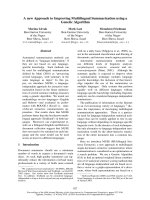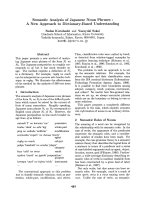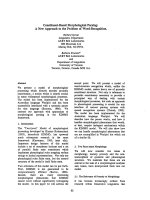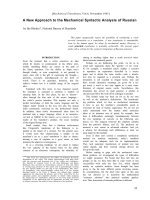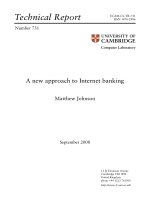A new approach to represent rotated haar
Bạn đang xem bản rút gọn của tài liệu. Xem và tải ngay bản đầy đủ của tài liệu tại đây (1.73 MB, 9 trang )
Journal of Theoretical and Applied Information Technology
10th August 2015. Vol.78. No.1
© 2005 - 2015 JATIT & LLS. All rights reserved.
ISSN: 1992-8645
www.jatit.org
E-ISSN: 1817-3195
A NEW APPROACH TO REPRESENT ROTATED HAAR-LIKE
FEATURES FOR OBJECTS DETECTION
1
MOHAMED OUALLA, 2ABDELALIM SADIQ, 3SAMIR MBARKI
Ibn Tofail University, Department of Informatics, Faculty of Sciences, Kenitra, Morocco
E-mail: , ,
ABSTRACT
In this paper, we propose a new approach to detect rotated object at distinct angles using the Viola-Jones
detector. Our method is based on two main steps: in the first step, we determine the rotated Haar-like
feature by any angle (45°, 26.5°, 63.5° and others), this allowed us to obtain a very large number of Haarlike features for use them during the boosting stage. The normal Integral Image is very easy to be
calculated, but for rotated Haar-like feature, their computation is practically very hard. For this reason, in
second step, we propose a function to calculate an approximate value of rotated Integral Image at a generic
angle. To concretize our method, we test our algorithm on two databases (Umist and CMU-PIE),
containing a set of faces attributed to many variations in scale, location, orientation (in-plane rotation), pose
(out-of-plane rotation), facial expression, lighting conditions, occlusions, etc.
Keywords:
1.
Haar-Like Feature, Integral Image, Object Detection, Face Detection, Viola & Jones
Algorithm.
Various methods have attempted to solve this
problem by introducing inclined features, by 45°
[8], 67,7° [9] [10] [11] [12], generic angles [45], in
the learning boosting stage.
INTRODUCTION
Object detection has been one of the most studied
topics in the computer vision literature. To detect
an object in an image, the detector must have
knowledge of the object characteristics. In fact, the
most important step in the objects detection is the
extraction of object features. Various approaches
have been utilized in this literature such as HaarLike features [4][5], color information, skin color
[3], etc. In this paper we will focus on Haar-Like
features.
The second challenge of the use of Haar-Like
features remains in how to present them practically.
For normal features, their presentation is easy to
achieve practically. Contrariwise, the presentation
of rotated features is a big challenge because the
presentation of an inclined rectangle, in an image, at
an angle different to 0°, would cause a distortion of
his sides, which makes the determination of integral
image very hard.
There are many motivations for using features
rather than the pixels directly. The most common
reason is that features can act to encode ad-hoc
domain knowledge that is difficult to learn using a
finite quantity of training data. For this system there
is also a second critical motivation for features: the
feature based system operates much faster than a
pixel-based system. [4]
The third challenge is manifested in how to
calculate the integral image of a rotated feature by
any angle. The normal Integral Image is very easy
to be calculated, that is done by summing the pixels
values above and to the left of the given pixel. But
for rotated Haar-like feature, their computation is
practically very hard; this is due to the distortion of
their sides caused by their rotation. So the
determination of the pixels forming these sides will
be very difficult, and this will lose the Integral
Image its simplicity and its quickness for which is
defined by Viola & Jones.
The use of Haar-Like features has three
challenges to be met. The first challenge is the
extent of its efficiency in the detection of objects.
Due to the non-invariant nature of the normal Haarlike features, classifiers trained with this method are
often incapable of finding rotated objects. It is
possible to use rotated positive examples during
training, but such a monolithic approach often
results in inaccurate classifiers [7]. For this reason
In this paper we present two algorithms. The first
determine the rotated haar-like features by any
angles. The second allows us to approximate the
15
Journal of Theoretical and Applied Information Technology
10th August 2015. Vol.78. No.1
© 2005 - 2015 JATIT & LLS. All rights reserved.
ISSN: 1992-8645
www.jatit.org
Viola & Jones introduced the integral image: Each
point of the integral image can be computed once
for an image. The integral image, denoted ii(x, y),
at location (x, y) contains the sum of the pixel
values
above
and
to
the
left
of
(x, y) (see figure 2-a), formally with equation (1).
Using the integral image, any rectangular sum can
be computed in four array references (see figure 2b). For example, to compute the sum of region A,
the following four references are required: 4+1(2+3).
∑ ′ i x′ , y′
ii x, y
(1)
rotated integral image at any angle. We show that
these algorithms are effective by giving some
practical examples, tests and results of comparison
with other methods.
The paper is organized as follows: a brief
description of the Viola-Jones methods and
algorithms are presented, including some important
extensions added by other authors. Next the
proposed method for determination of rotated Haarlike feature at a set of suitable angles is explained.
The following section presents practical examples.
Finally the conclusions point out the limitations and
some challenges on a generic rotation invariant
detector using Haar-like features.
2.
′
1
RELATED WORK
ii(x,y)
Since their apparition by Papageorgiou et
al. [1] that they have introduced a general
framework for object detection using a Haar
wavelet representation [2] until they become more
famous when Viola and Jones [4][5][6] have
proposed to use them for their face detection
algorithm, Haar-like features has become an
increasingly indispensable tool for extracting
information that characterizes an elected object to
be detected.
(a)
4
(b)
Detectors trained by the group of features
in figure 1, have shown their limitation to detect
rotated objects. Therefore Lienhart et al. [8]
introduced an extended set of twisted Haar-like
feature at 45°. But also with this extension we
cannot detect rotated objects by angles other than
45°. For this reason Barczack [9] proposes a new
approach to detect rotated objects at distinct angles
using the Viola-Jones detector. The use of
additional Integral Images makes an approximation
to the value of Haar-like features for any given
angle. The proposed approach uses different types
of Haar-like features, including features that
compute areas at 45°, 26.5° and 63.5° of rotation.
Barczak continued his work with Mossom [10][11]
where they used angles which their tangents are
rational numbers which allows the use of different
angles. If we consider α one of these angles we will
have α= arctan (Y/X) where X and Y are integers
and X or Y is 1. With this method, the rotated
objects by an angle arctan (Y/X) such that X and Y
are different from 1, cannot be detected.
Subsequently Ramirez et al [13] introduce the use
of asymmetric Haar features, eliminating the
D
F
E
2
A
Viola and Jones used a customized version
of Adaboost to aggregate the weak classifiers. One
of the changes made to the algorithm was the
creation of many layers (called cascades), each one
being trained by several rounds of Adaboost to
create strong classifiers that can detect if an area of
an image contains the desired object or not.
(a)
B
3
Figure 2: The integral image of (a) a point and (b) a
rectangle
C
A
E-ISSN: 1817-3195
H
G
Figure 1: Example rectangle features shown relative
to the enclosing detection window.
Figure 1-(a) shows the normal Haar-like
features defined by Viola and Jones [4]. The
principle of their algorithm, which is a boosting
algorithm, is to classify an area of the image as face
or non-face from multiple weak classifiers (a weak
classifier is just a Haar-like feature with a weight)
having a good classification rate slightly better than
random classifier. These weak classifiers consist of
summing pixels at select areas (rectangular) of the
image and to subtract them with other. In order to
reduce the computational cost of the summations,
16
Journal of Theoretical and Applied Information Technology
10th August 2015. Vol.78. No.1
© 2005 - 2015 JATIT & LLS. All rights reserved.
ISSN: 1992-8645
www.jatit.org
Messom et al. [9] but with the restriction that X or
Y and X or Y is 1, contrariwise, in our method
these variables are positive integers that can have
any value. The angles chosen are those having a
rational tangent. A 45° rotated Haar-like feature is a
special case of a feature which X
Y and
X
Y . Each rectangle is encapsulated by another
normal (see figure 3) having the following size:
, H
requirement of equalized positive and negative
regions in a feature. They propose Haar features
with asymmetric regions that can have regions with
either different width or height, but not both.
3.
E-ISSN: 1817-3195
ROTATED HAAR-LIKE FEATURES
A detector trained by the features proposed
by Lienhart et al [8] and those proposed by Barczak
[9] can only be built by the angles 45°, 26.57°,
63.43° and others cited in [10][11]. And as
mentioned above, this detector will have difficulties
to detect rotated object by any other angle. The
normal features and the rotated features are not
mathematically equivalent in digital processing due
to the fact that the rotated Integral Image needs
slightly distorted rectangles to correctly compute an
area.
and W
window (in our case we are using a base resolution
of 24x24).
Indeed,
in
a
window
training
Win(Wwin,Hwin), a rotated rectangle (ABCD) is a
rectangle witch its bottom-left corner is A(xA,yA)
and which its sides [AB] and [AC] form two areas,
respectively, Barea and Carea (figure 4). Each area
consists of a set of points, each point represents a
pixel. The two sets may be expressed in the
following way.
Our idea is simple, and consists of
scanning the window used during the training stage
(base resolution of 24x24), and at the level of each
point, determine all possible rectangles that are
rotated by different angles. This current point
represents the bottom-left corner of each rectangle
found. Our method don’t fix the number of angles
to use from the beginning of training stage as they
did the authors of [8], [9], [10] and [11]. The
number of angles used varies from one window to
another depending on its base resolution.
!" #$%& , '%& ( ∈ *+,/$. / $%& / *012
4,5'. / '%& / 6012 7
(2)
8
!9 #$%: , '%: ( ∈ *+,/0 < $%: / $.
(3)
4,5'. / '%: / 6012 7
ABCD
?@
?>
α
=@
=>
EBCD
Figure 3: Representation of the rotated rectangle
and its rectangle that encapsulates it
A general rotation, by any angle, cannot be
easily implemented; therefore we define a restricted
set of rotations that can be easily and effectively
implemented. This set contains valid angles which
represent the rotated rectangles preserving their
integrity. A rotated Haar-like feature is a feature
that has been rotated by a valid angle α
arctan
where X , Y , X and
arctan
Figure 4 : Determination of the valid rectangles for a
point A(xA,yA)
Therefore, to determine the valid
rectangles at level of point A(xA,yA) (i.e. the
rectangles that their integrity is preserved,
otherwise, those for which their angles are rights ),
we must determine the couples (PB ,αB) such as αB
is possible angle of the orientation of the side
Y are integers (figure 3). Such angles was used by
17
Journal of Theoretical and Applied Information Technology
10th August 2015. Vol.78. No.1
© 2005 - 2015 JATIT & LLS. All rights reserved.
ISSN: 1992-8645
www.jatit.org
Lienhart et al. [8] have given a method to
calculate the rotated Integral Image by 45° (as they
named it: Twisted Integral Image) as shown in
figure 5. The computing operation for all the
features follows the same rule; the value of a pixel
is calculated by summing the pixels values obtained
by moving, since this pixel, firstly from one step to
the left and then another on top and secondly from
one step to the left and then another down (figure
5(a)). However, for the rotated feature by an angle
different of 45°, the possibility of finding a rule to
browse the pixels of a rectangle becomes very
difficult.
[APB] (figure 4). As already mentioned above,
α
arctan
Where:
Y
FYG H YI FandX
FX G H XI F
In the same way, we determine the couples (PC ,αC).
The couples of the two areas can be expressed as
follows:
BL
P , α /P ∈ BNOPN
(4)
arctan
andα
whereY
CL
FyG H yI FandX
FxG H xI F}
P , α /P ∈ CNOPN
arctan
andα
whereY
FyG H yI FandX
(5)
For this raison, and because we have to
deal with thousands of rectangles, obtained by our
algorithm, representing different angles and
dimensions, we propose a function to calculate an
approximate value of rotated integral image at a
generic angle.
FxG H xI F7
Therefore, the rotated valid rectangles,
called RhlA, by an angle αv are those in which their
side [APB] is rotated by that same angle in such a
way that there is a side [APC] rotated by an angle αC
provided that these two angles are complementary,
Otherwise:
P , P , αW / P , αW ∈ BL
RhlI
and∃ P , α ∈ CL suchasαW [ α
4.2 Rotated Feature Computation
4.2.1
Principle
The principle of our technique consists in
dividing each normal rectangle, which encapsulates
the rotated rectangle, in several other normal.
Thereafter, according to the integral image of these
rectangles, we calculate that of the rotated
rectangle.
(6)
90°7
As a final result, all rotated rectangles that
we can obtain from a training window Win is:
Rhl
∪I∈_`a RhlI .
(7)
Given that the base resolution of the
detector is 24x24, the exhaustive set of rotated
rectangle features is quite large, 130000.
4.
E-ISSN: 1817-3195
A Haar-Like feature is a rectangle
composed either of 2, 3 or 4 rectangles (see figure
1). Each rectangle, called r, is identified by 4
points: A(xA,yA), B(xB,yB), C(xC,yC) and D(xD,yD),
such as point D can be determined based on three
other points as follows: xD=xC+xB-xA and
yD=yC+yB-yA. Each rectangle r is encapsulated in
another, normal, called R as shown in figure 3. The
rectangles r are grouped together in the set Rhl
(formula 7), this set consists of two classes Rhla and
Rhlb which are defined as follows:
INTEGRAL IMAGE
4.1 Problematic
The normal Integral Image for a given
normal feature is very easy to be calculated. This is
done by summing the pixels values above and to
the left of the given pixel (figure 2). For rotated
integral image, their computation is, practically,
very hard.
RhlN
r ∈ Rhl/ y b y andxI b xc
OR y < y andxI < xc 7 (8)
Rhle
r ∈ Rhl/ y f y andxI / xc
OR y / y andxI f xc 7
(9)
Each class has two subclass; the first one
is grouping the rectangles oriented to the left named
RhlaL and RhlbL(figure 6(a) and 6(c)) defined,
respectively, by the formulas 10 and 12. The
second includes those oriented to the right named
RhlaR and RhlbR (figure 6(b) and 6(d)) expressed by
11 and 13.
Figure 5: Twisted Integral image representation.
(a) The value of the twisted Integral Image at
point (x,y). (b) Calculation scheme of the pixel
sum of rotated rectangles by 45°.
18
Journal of Theoretical and Applied Information Technology
10th August 2015. Vol.78. No.1
© 2005 - 2015 JATIT & LLS. All rights reserved.
ISSN: 1992-8645
www.jatit.org
E-ISSN: 1817-3195
R4
R1
R4
R1
R5
R5
R2
R3
R2
R3
(b)
(a)
R1
R4
R7
R5
R1
R4
R6
R6
R3
R2
R3
R5
R7
R2
(d)
(c)
Figure 6: Representation of the rotated rectangle of (a) class RhlaL, (b) class RhlaR, (c) class RhlbL and (d)
class RhlbR.
RhlNg
r ∈ RhlN /y < y andxI < xc 7 (10)
RhlNh
r ∈ RhlN /y b y andxI b xc 7 (11)
Rhleg
r ∈ Rhle /y f y andxI / xc 7 (12)
Rhleh
r ∈ Rhle /y / y andxI f xc 7 (13)
So we deduced that: RhlN
Rhle Rhleg ∪ Rhleh .
α is different from 45° and will have a very
important execution time which takes away, to the
technique of the integral image, its simplicity and
rapidity. For this reason we have calculated them
p
I /i ∈
with an approximate way as follows: Ikl
t hl
1,2, . . ,77 H 57, Where: Ihl is the integral image of
rectangle Ri. So the two formulas (14) and (15)
become:
RhlNg ∪ RhlNh and
4.2.2
Computing the Integral Image
As already mentioned, the rectangle R is
split into several normal rectangles called Ri. As
shown in figure 6, the Rhla category allows the
division into five rectangles while Rhlb category
allows seven. Then theoretically the integral image
value of the rectangle r, for both categories, is
expressed by the following equations:
RhlN :IO
∑n`op Ikl
[ I hm
(14)
Rhle :IO
∑q`op Ikl
`rs
H I hm
(15)
RhlN :IO
p
∑n`op Ihl [ Ihm
(16)
Rhle :IO
p
∑q`op Ihl H Ihm
(17)
t
t
`rs
α
R4
t4
t3
R3
R5
R1
t1
t2
R2
Where: Ikl are integral images of triangles
ti such as i=1, 2, 3, 4, 6 or 7. ti is half of the
rectangle Ri that intersects r (figure 7). IR5 is the one
of the rectangle R5. But, practically, the calculation
of these integral images is very difficult if the angle
Figure 7: Representation of the rectangle r, rotated
by an angle α. r is divided into four triangles and
one rectangle in the middle for class Rhla and six
triangles and one rectangle in the middle for class
Rhlb.
19
Journal of Theoretical and Applied Information Technology
10th August 2015. Vol.78. No.1
© 2005 - 2015 JATIT & LLS. All rights reserved.
ISSN: 1992-8645
www.jatit.org
Table 1: Comparison with other methods
Discussion
In addition to the two above mentioned
advantages, which are speed and simplicity, our
technique allows involving the neighbouring pixels
of the rectangle in computing of the integral image
and this is very important because any component
of the object to detect cannot be isolated from its
environment. Take for example the detection of
faces; a face consists of several determinant
components such as the eyes, nose, mouth, etc. If
we consider a rotated rectangle on an eye as shown
in figure 8, the value of the integral image of this
rectangle also helps to inform us about the
eyebrows and eyelashes also. And this, of course as
we believe, provides a wealth of information about
a rectangle. And more if we consider the Rhle
category, the calculation is performed by the
intervention, on several occasions, of the pixels
forming the rectangle, and this allows them to
acquire a very important weight compared to
neighbouring pixels.
Lienhart
(45° )&
Barczack
(26,57°)
A
B
C
D
E
F
G
H
Total
18302
18302
10828
10828
8152
7150
7150
2826
83538
Our method
Differences
4.2.3
Types of
features
So in this way, we preserve the main
advantage, for which the integral image is given for
the first time by Viola and Jones, which consists of
minimizing the memory access. The number of
access is 12 for classRhlN, and 18 for class Rhle .
45° &
26,57°
Other
angles
Total
18302
18302
10828
10828
8152
7150
7150
2826
83538
13432
13432
5434
5434
4520
2388
2388
846
47874
31734
31734
16262
16262
12672
9538
9538
3672
131412
13432
13432
5434
5434
4520
2388
2388
846
47874
Table 2 shows the number of rotated
rectangles by a given angle for the type A. As we
can see, the total number of angles obtained for the
type A is 50, obviously it's a big number. Table 3
shows the number of angles used for each type.
Table 2: Angles used for type A (57)
Figure 8 : Rectangle and its surroundings.
5.
E-ISSN: 1817-3195
EXPERIMENTAL RESULTS
5.1 Test results and statistics
In this section we present some statistics
on the results obtained by applying the method
explained in section 3. The results are given relative
to types of normal Haar-like features showed in
figure1.
*A
*N
A
N
A
N
A
N
45
10626
12,53
48
59,04
229
41,19
2
26,57
3838
71,57
1766
51,34
148
82,87
134
18,43
1766
56,31
1050
39,81
60
69,44
54
14,04
930
36,87
380
35,54
35
57,99
18
11,31
532
30,96
229
32,01
18
48,81
2
9,46
312
23,2
93
29,05
5
83,66
81
8,13
206
20,56
54
80,54
312
77,47
48
7,13
134
16,7
8
50,19
60
66,04
14
6,34
81
75,96
930
40,6
20
60,95
5
5,71
40
53,13
380
81,87
206
84,29
40
5,19
11
38,66
148
74,05
140
73,3
8
63,43
3838
29,74
58
66,8
93
84,81
11
33,69
1050
23,96
14
60,26
58
21,8
342
78,69
532
54,46
35
140
342
20
15,95
68,2
49,4
*A: Rotation angle
*N: Number of rectangles for the angle A
Table 3: Number of angles used for each type of feature
Table 1 shows a comparison with the
method used by Lienhart et al. [8] and that
proposed by Barczak et al. [9]. The results show
that with our method, we can use a large number of
features of different angles in the construction of
detector, which can reach a difference of 47874
features with these methods, which increases its
performance in detecting objects at different poses.
20
Type of feature
Number of the angles
A
B
C
D
E
F
G
H
57
57
27
27
41
17
17
17
Journal of Theoretical and Applied Information Technology
10th August 2015. Vol.78. No.1
© 2005 - 2015 JATIT & LLS. All rights reserved.
ISSN: 1992-8645
www.jatit.org
E-ISSN: 1817-3195
To compare our face detectors accuracy,
we constructed the ROC curves shown in figure 9.
These statistics show that our algorithm
allows us to use a maximum number of different
sized features and rotated by a variety of angles
between 0° and 90°. These angles varies according
to the resolution of the training window what has
allows us to detect faces in different poses.
The majority of faces contained in the PIE
database are Asian, for this reason PIE-Detector has
difficulty to detect the faces of the MIT+CMU test
set. Indeed it can be noted that the detection rate of
UMIST-Detector is better than that of PIEDetector. And also, according to the results
presented in [4], [8] and [10], our detectors present
detections rates better than those given by Viola,
Lienhart and Barczack.
5.2 Practical examples
The algorithms proposed in this paper are
designed to detect any type of object in an image.
So to evaluate the robustness of these algorithms,
we tested them for faces detection.
At the end of this paper you will find the
figure 10 that illustrates some detection results
using our Umist- detectors based on the MIT+CMU
test sets.
5.2.1
Training data
In our test, we have used two databases
that are Umist [17] and CMU-PIE [16] which
contains frontal and rotated faces. These faces are
rotated by different angles and were subjected to
changes in contrast, light etc. Also are scaled to a
resolution of 24x24 pixels. The Umist database
contains 6900 Images while CMU-PIE contains
9996.
6.
CONCLUSION AND FUTURE WORK
In this paper, we have proposed a method
to determine a large number of rotated Haar-like
features by any angle. This number varies
according to the size of the training window. We
have also proposed a new method that calculates
the approximate value of the rotated integral image;
this has allowed us to keep the two major
characteristics for which the integral image is
proposed for the first time, which are: simplicity
and speed.
The non-face examples used to train a
classifier were extracted online from 3020 images
of sizes varying from 320x240 to 512x512, in
which there is no face. In our experiments, the
training dataset and the testing dataset are
completely separated and non-overlapped.
To evaluate our algorithm we have tested
it on two widely known databases; CMU-PIE set
and Umist set, and as we have noted above, our
algorithm presents detections rate better than that
obtained by other methods such as those of
Lienhart and Barczak.
5.2.2
Results
In our experiments, two different cascades
of face detectors are trained and evaluated. The first
one that we called Umist-Detector, is trained by
Umist set and is composed from 20 stages, the
second is trained by the CMU-PIE set and is
composed from 14 stages, we refer to this detector
as PIE-Detector.
Our perspectives are manifested by two
challenges. The first is to improve the training time,
for this reason we are working on optimizing the
overall number of Haar-like features. The second
one is to test our method on other disciplines such
as Hand Tracking, detection of pedestrian, vehicle
detection, etc.
For the evaluation of the performance of
our faces detector, we used, as most of other
methods, MIT + CMU rotated test set [14] that we
can easily find in [15]. This test set is one of the
most commonly used datasets for assessing the
performance of face-detection algorithms. This
dataset is composed of 180 images containing about
500 faces of different sizes and poses. The large
variations in image quality and in the scale of the
faces greatly increase the difficulty of the facedetection task. Post-processing was the same as in
[6]. The experiments were done on a 2.40GHz Intel
Core i3 PC with 4 GB memory.
REFRENCES:
[1] M. Oren, C. Papageorgiou, P. Sinha, E.
Osuna, and T. Poggio. “Pedestrian detection
using wavelet template”. In computer Vision
and Pattern Recognition, pages 193-99, 1997.
[2] S.Mallat. “A theory for multiresolution signal
decomposition: The wavelet representation”.
IEEE Transactions on pattern Analysis and
21
Journal of Theoretical and Applied Information Technology
10th August 2015. Vol.78. No.1
© 2005 - 2015 JATIT & LLS. All rights reserved.
ISSN: 1992-8645
[3]
[4]
[5]
[6]
[7]
[8]
[9]
[10]
[11]
[12]
[13]
www.jatit.org
Machine Intelligence, 11(7):674-93, July
1989.
S. L. Phung, A. Bouzerdoum, and D. Chai,
“Skin segmentation using color pixel
classification: Analysis and comparison”,
PAMI, vol. 27, no. 1, pp. 148-154, 2005.
P. Viola and M. Jones “Rapid Object
Detection Using a Boosted Cascade of Simple
Features”,
IEEE
Computer
Society
Conference on Computer Vision and Pattern
Recognition, Vol. 1, pp. 511-518, 2001.
M. J. Jones and P. Viola, “Robust real-time
object detection” Tech. Rep. CRL-2001-1,
Hewlett Packard Laboratories, Feb. 25 2001.
P. Viola and M. J. Jones. Robust real-time
face detection. Int. J. Comput. Vision,
57(2):137–154, 2004.
M. J. Jones and P. Viola, “Fast multi-view
face detection” Tech. Rep. TR2003-96,
MERL, July 2003.
R. Lienhart and J. Maydt, “An Extended Set
of Haar-like Features for Rapid Object
Detection”, IEEE ICIP 2002, Vol. 1, pp. 900903, 2002.
A. L. C. Barczak. “Toward an Efficient
Implementation of a Rotation Invariant
Detector
using
Haar-Like
Features”,
Proceedings of the IEEE/RSJ international
conference on Intelligent robots and systems,
Nouvelle-Zélande, Dunedin, 2005
C. H. Messom, A. L. C. Barczak, “Stream
processing for fast and efficient rotated Haarlike features using rotated integral images”.
IJISTA 7(1): 40-57 (2009).
C. H. Messom, A. L. C. Barczak, “Stream
Processing of Integral Images for Real-Time
Object Detection”. PDCAT 2008: 405-412.
S. Du, N. Zheng, Q. You, Y. Wu, M. Yuan,
and J. Wu, "Rotated Haar-Like Features for
Face Detection with In-Plane Rotation", 12th
International Conference, VSMM 2006,
Xi’an, China, October 18-20, 2006.
Proceedings, pp 128-137.
G. A. Ramirez, O. Fuentes, “Multi-Pose Face
Detection With Asymmetric Haar Features”,
Applications of Computer Vision, WACV,
2008,
IEEE
Workshop
in
Copper
Mountain,CO.
E-ISSN: 1817-3195
[14] Rowley, H., Baluja, S., Kanade, T.: “Neural
network-based face detection”, In IEEE Trans.
Pattern Analysis and Machine Intelligence, 20
(1998) 23–38.
[15] CMU/VASC
Image
Database:
“http:
//vasc.ri.cmu.edu/idb/html/face/frontal_
images/”.
[16] PIE
DataBase :
“ />research_project_detail.html?project_id=4
18&menu_id=261”.
[17] Umist
Database:
“ffield.
ac.uk/eee/research/iel/research/face”
22
Journal of Theoretical and Applied Information Technology
10th August 2015. Vol.78. No.1
© 2005 - 2015 JATIT & LLS. All rights reserved.
ISSN: 1992-8645
www.jatit.org
E-ISSN: 1817-3195
Figure 9: The ROC curves of the Umist-Detector and the PIE-Detector using the MIT + CMU test set.
Figure 10: Some detection results using our Umist-Detector on the MIT + CMU test set.
23


